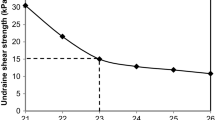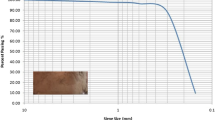Abstract
Stone columns are used as a technique for improving the strength and enhancing the bearing capacity of soft soils. Due to the low confinement of the soil typically surrounding the stone columns, reinforcement materials like geotextile are needed to improve such weakness. Although the technique is now well established, little research has been undertaken on the use of various positions of the reinforcement materials. In this paper, some small-scale laboratory tests were performed on reinforced floating stone columns with diameters of 80 mm and 100 mm and the length of 400 mm and 500 mm, respectively, to study the influence of various positions of geotextile. They were included vertical encasement stone columns, horizontal reinforcement stone columns and combined vertical–horizontal encasement stone columns. The impacts of the different diameters of the columns, the length of the reinforcement and the spaces of the reinforcement have been studied. Based on the results, by increasing the diameter of the vertical encasement stone column, the benefit of encasement decreases, while in horizontal and vertical–horizontal encasement stone column, the performance of the reinforcement increases. Moreover, the load-carrying capacity of combined vertical–horizontal encasement stone columns increases considerably in comparison with the other types.









Similar content being viewed by others
References
Barksdale RD, Bachus RC (1983) Design and construction of stone columns. Report No. FHWA/RD-83/026, Office of Engineering and Highway Operations Research and Development, Federal Highway Administration, Washington
Greenwood DA (1970) Mechanical improvement of soils below ground surfaces. In: Proceedings of conference on ground engineering, Institute of Civil Engineers, London, pp 11–22
Vesic AS (1972) Expansion of cavities in infinite soil mass. J Soil Mech Found Div 98(SM3):265–290
Madhav MR, Vitkar PP (1978) Strip footing on weak clay stabilized with a granular trench or pile. Can Geotech J 15(4):605–609. https://doi.org/10.1139/t78-066
Aboshi H, Ichimoto E, Harada K, Emoki M (1979) The composer-a method to improve the characteristics of soft clays by inclusion of large diameter sand columns. In: Proceedings international conference on soil reinforcement, Paris, pp 211–216
Shivashankar R, Babu MRD, Nayak S (2011) Performance of stone columns with circumferential nails. Proc Inst Civil Eng 164(2):97–106. https://doi.org/10.1680/grim.2011.164.2.97
Van Impe WF (1986) Improving of the bearing capacity of weak hydraulic fills by means of geotextiles. In: Proceedings of the 3rd international conference on geotextiles, Vienna, Austria, pp 1411–1416
Malarvizhi SN, Ilamparuthi K (2007) Comparative study on the behavior of encased stone column and conventional stone column. Soils Found 47(5):873–885. https://doi.org/10.3208/sandf.47.873
Verma S, Kumar V, Priyadarshee A (2018) An experimental test study on ring footing resting on clay bed reinforced by stone column. Innov Infrastruct Solut 3(1):64. https://doi.org/10.1007/s41062-018-0169-9
Bhatia R, Kumar A (2019) Model tests on geosynthetic-encased construction concrete debris column in fly ash fill. Innov Infrastruct Solut 4:31. https://doi.org/10.1007/s41062-019-0217-0
Murugesan S, Rajagopal K (2007) Model tests on geosynthetic-encased stone columns. Geosynth Int 14(6):346–354. https://doi.org/10.1680/gein.2007.14.6.346
Chen JF, Wang XT, Xue JF, Zeng Y, Feng SHZ (2018) Uniaxial compression behavior of geotextile encased stone columns. Geotext Geomembr 46(3):227–283. https://doi.org/10.1016/j.geotexmem.2018.01.003
Gniel J, Bouazza A (2009) Improvement of soft soils using geogrid encased stone columns. Geotext Geomembr 27(3):167–175. https://doi.org/10.1016/j.geotexmem.2008.11.001
Murugesan S, Rajagopal K (2010) Studies on the behavior of single and group of geosynthetic encased stone columns. J Geotech Geoenviron Eng 136(1):129–139. https://doi.org/10.1061/(ASCE)GT.1943-5606.0000187
Ali K, Shahu JT, Sharma KG (2012) Model tests on geosynthetic-reinforced stone columns: a comparative study. Geosynth Int 19(4):292–305. https://doi.org/10.1680/gein.12.00016
Dash SK, Bora MC (2013) Influence of geosynthetic encasement on the performance of stone columns floating in soft clay. Can Geotech J 50:754–765. https://doi.org/10.1139/cgj-2012-0437
Lajevardi SH, Enami S, Hamidi M, Shamsi HR (2018) Experimental study of single and groups of stone columns encased by geotextile. J Sci Technol. https://doi.org/10.22060/CEEJ.2018.12789.5269
Madhav MR (1982) Recent development in the use and analysis of granular piles. In: Proceedings of symposium on recent development in ground improvement techniques, Bangkok, pp 117–129
Sharma RS, Phani Khumar BR, Nagendra G (2004) Compressive load response of granular piles reinforced with geogrids. Can Geotech J 41(1):187–192. https://doi.org/10.1139/t03-075
Ayadat T, Hanna AM, Hamitouche A (2008) Soil improvement by internally reinforced stone columns. Proc Inst Civ Eng-Ground Improv 161(2):55–63. https://doi.org/10.1680/grim.2008.161.2.55
Ghazavi M, Yamchi AE, Nazari Afshar J (2018) Bearing capacity of horizontally layered geosynthetic reinforced stone. Geotext Geomembr 46:312–318. https://doi.org/10.1016/j.geotexmem.2018.01.002
Prasad SSG, Satyanarayana PVV (2016) Improvement of soft soil performance using stone columns improved with circular geogrid discs. Indian J Sci Technol 9(30):1–6. https://doi.org/10.17485/ijst/2016/v9i30/99186
Ali K, Shahu JT, Sharma KG (2014) Model tests on single and groups of stone columns with different geosynthetic reinforcement arrangement. Geosynth Int 21(2):103–118. https://doi.org/10.1680/gein.14.00002
Mohammad Rezaei M, Lajevardi SH, Saba HR, Ghalandarzadeh A, Zeighamie E (2019) Experimental and numerical studies on load-carrying capacity of single floating aggregate piers reinforced with vertical steel bars. Amirkabir J Civil Eng. https://doi.org/10.22060/CEEJ.2019.15640.5991
Hasan M, Samadhiya NK (2017) Performance of geosynthetic-reinforced granular piles in soft clays: model tests and numerical analysis. Comput Geotech 87:178–187. https://doi.org/10.1016/j.compgeo.2017.02.016
Madhav MR, Miura N (1994) Soil improvement. Panel report on stone columns. In: Proceedings of the 13th international conference on soil mechanics and foundation engineering, vol 5, New Delhi, India, pp 163–164
Wood DM, Hu W, Nash DFT (2000) Group effects in stone column foundations: model tests. Geotechnique 50(6):689–698. https://doi.org/10.1680/geot.2000.50.6.689
ASTM D4253-00, 2006 (2006) Standard test methods for maximum index density and unit weight of soils using a vibratory table. ASTM International, West Conshohocken. https://doi.org/10.1520/D4253-00R06
ASTM D4254-00, 2006-e1 (2006) Standard test methods for minimum index density and unit weight of soils and calculation of relative density. ASTM International, West Conshohocken. https://doi.org/10.1520/D4254-00R06E01
ASTM D2216-10 (2010) standard test methods for laboratory determination of water (moisture) content of soil and rock by mass. ASTM International, West Conshohocken. https://doi.org/10.1520/D2216-10
ASTM D2166-06 (2006) Standard test method for unconfined compressive strength of cohesive soil. ASTM International, West Conshohocken. https://doi.org/10.1520/D2166-06
ASTM D854-06e1 (2006) Standard test methods for specific gravity of soil solids by water pycnometer. ASTM International, West Conshohocken. https://doi.org/10.1520/D0854-06E01
ASTM D4318-05 (2005) Standard test methods for liquid limit, plastic limit, and plasticity index of soils. ASTM International, West Conshohocken. https://doi.org/10.1520/D4318-05
ASTM D3080-98 (2003) Standard test method for direct shear test of soils under consolidated drained conditions. ASTM International, West Conshohocken. https://doi.org/10.1520/D3080-03
ASTM D2487-06e1 (2006) Standard practice for classification of soils for engineering purposes (unified soil classification system). ASTM International, West Conshohocken. https://doi.org/10.1520/D2487-06E01
Iai S (1989) Similitude for shaking table tests on soil-structure fluid models in 1 g gravitational field. Soil Found 29(1):105–118. https://doi.org/10.3208/sandf1972.29.105
Alexiew D, Brokemper D, Lothspeich S (2005) Geotextile encased columns (GEC): load capacity, geotextile selection and pre-design graphs. In: Geo-frontiers Conference, Austin, Texas, pp 497–510. https://doi.org/10.1061/40777(156)12
ASTM D4595-11 (2011) Standard test method for tensile properties of geotextiles by the wide-width strip method. ASTM International, West Conshohocken. https://doi.org/10.1520/D4595-11
Mohammad Rezaei M, Lajevardi SH, Saba HR, Ghalandarzadeh A, Zeighami E (2019) Laboratory study on single stone columns reinforced with steel bars and discs. Int J Geosynth Ground Eng 5(2):1–14. https://doi.org/10.1007/s40891-019-0154-1
Shahu JT, Reddy YR (2011) Clayey soil reinforced with stone column group: model tests and analyses. J Geotech Geoenviron Eng 137(12):1265–1279. https://doi.org/10.1061/(ASCE)GT.1943-5606.0000552
Indian Standard (IS) (2003) Design and construction for ground improvement-Guidelines. Part 1: stone columns. IS: 15284, Bureau of Indian Standards, New Delhi, India
Kumar G, Samanta M (2020) Experimental evaluation of stress concentration ratio of soft soil reinforced with stone column. Innov Infrastruct Solut. https://doi.org/10.1007/s41062-020-0264-6
Debnath P, Dey AK (2017) Bearing capacity of geogrid reinforced sand over encased stone columns in soft clay. Geotext Geomembr 45(6):653–664. https://doi.org/10.1016/j.geotexmem.2017.08.006
Hamidi M, Lajevardi SH (2018) Experimental study on the load-carrying capacity of single stone columns. Int J Geosynth Ground Eng 4(26):1–10. https://doi.org/10.1007/s40891-018-0142-x
Ambily AP, Grandhi SR (2007) Behavior of stone columns based on experimental and FEM analysis. J Geotech Geoenviron Eng 133(4):405–415. https://doi.org/10.1061/(ASCE)1090-0241(2007)133:4(405)
Nazari Afshar J, Ghazavi M (2014) Experimental studies on bearing capacity of geosynthetic reinforced stone columns. Arab J Sci Eng 39(3):1559–1571. https://doi.org/10.1007/s13369-013-0709-8
Ghazavi M, Nazari Afshar J (2013) Bearing capacity of geosynthetic encased stone columns. Geotext Geomembr 38:26–36. https://doi.org/10.1016/j.geotexmem.2013.04.003
Lajevardi SH, Shamsi HR, Hamidi M, Enami S (2018) Numerical and experimental studies on single stone columns. Soil Mech Found Eng 55(5):340–345. https://doi.org/10.1007/s11204-018-9546-9
Castro J (2017) Groups of encased stone columns: influence of column length and arrangement. Geotext Geomembr 45:68–80. https://doi.org/10.1016/j.geotexmem.2016.12.001
Almeida MSS, Hosseinpour I, Riccio M, Alexiew D (2013) Behavior of geotextile-encased granular columns supporting test embankment on soft deposit. J Geotech Geoenviron Eng 141(3):04014116. https://doi.org/10.1061/(ASCE)GT.1943-5606.0001256
Author information
Authors and Affiliations
Corresponding author
Rights and permissions
About this article
Cite this article
Bazzazian Bonab, S., Lajevardi, S.H., Saba, H. et al. Experimental studies on single reinforced stone columns with various positions of geotextile. Innov. Infrastruct. Solut. 5, 98 (2020). https://doi.org/10.1007/s41062-020-00349-0
Received:
Accepted:
Published:
DOI: https://doi.org/10.1007/s41062-020-00349-0




